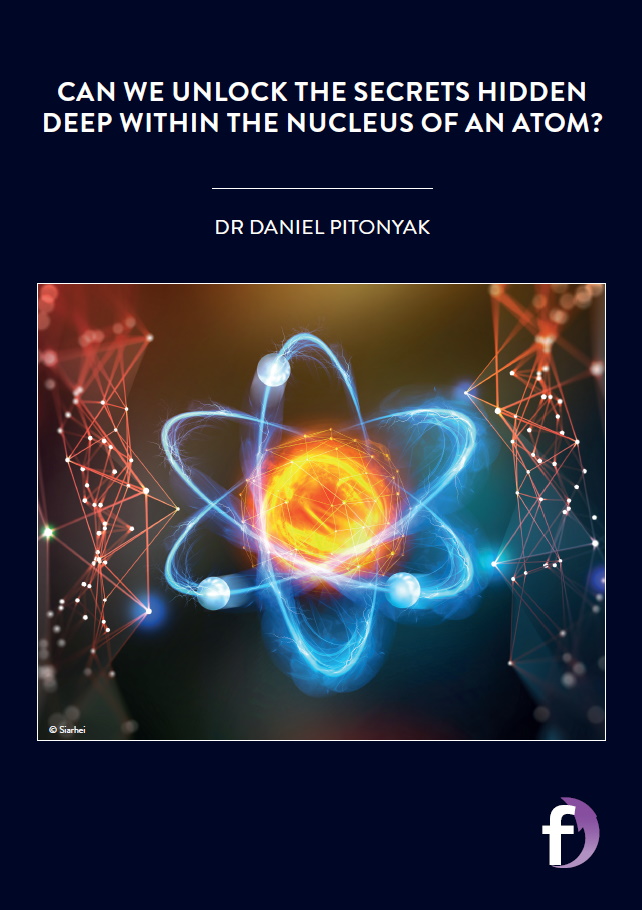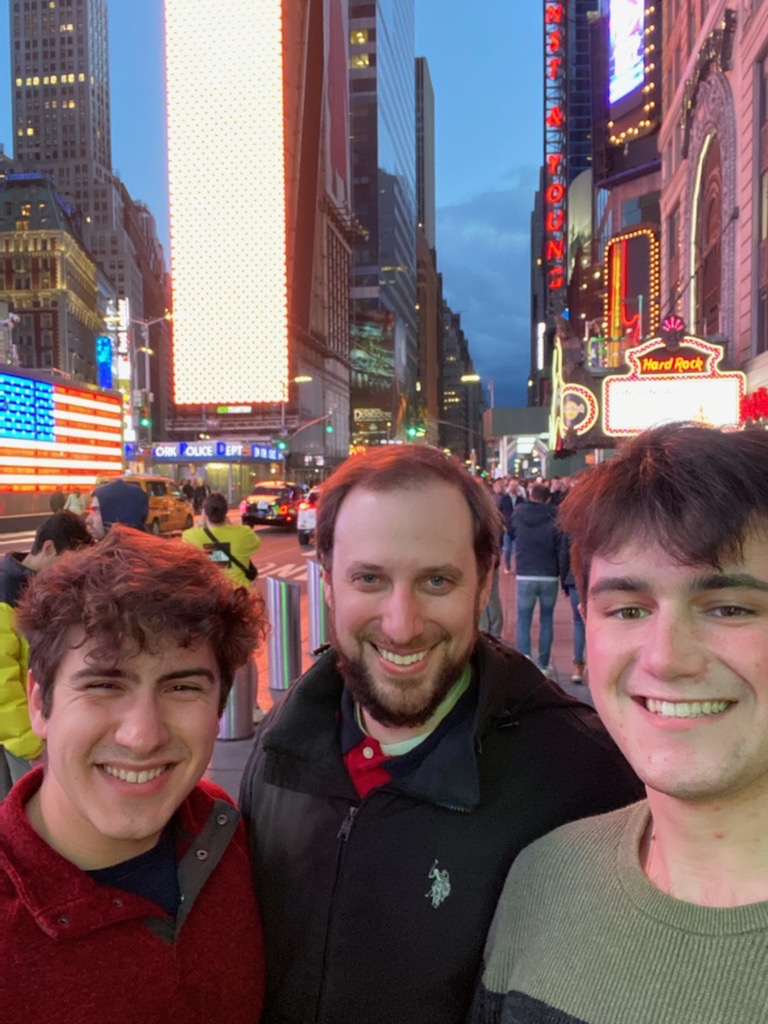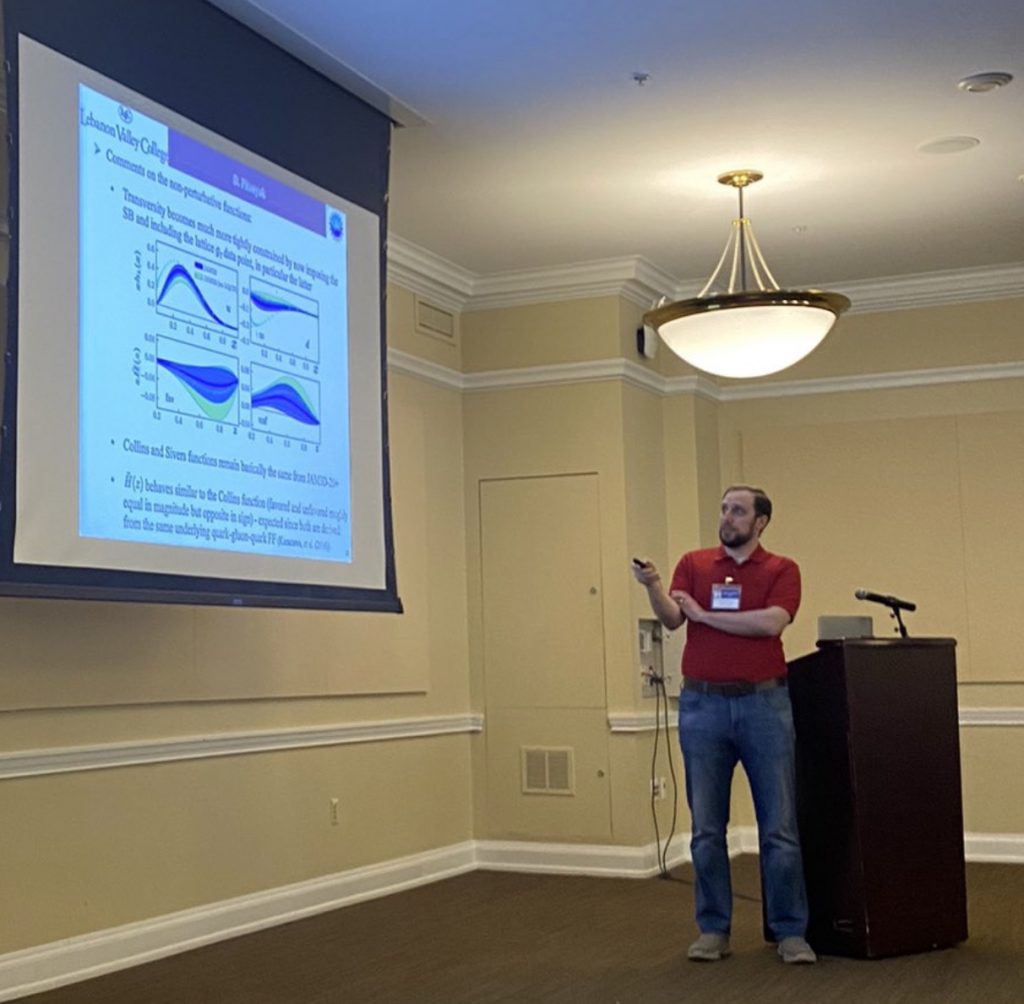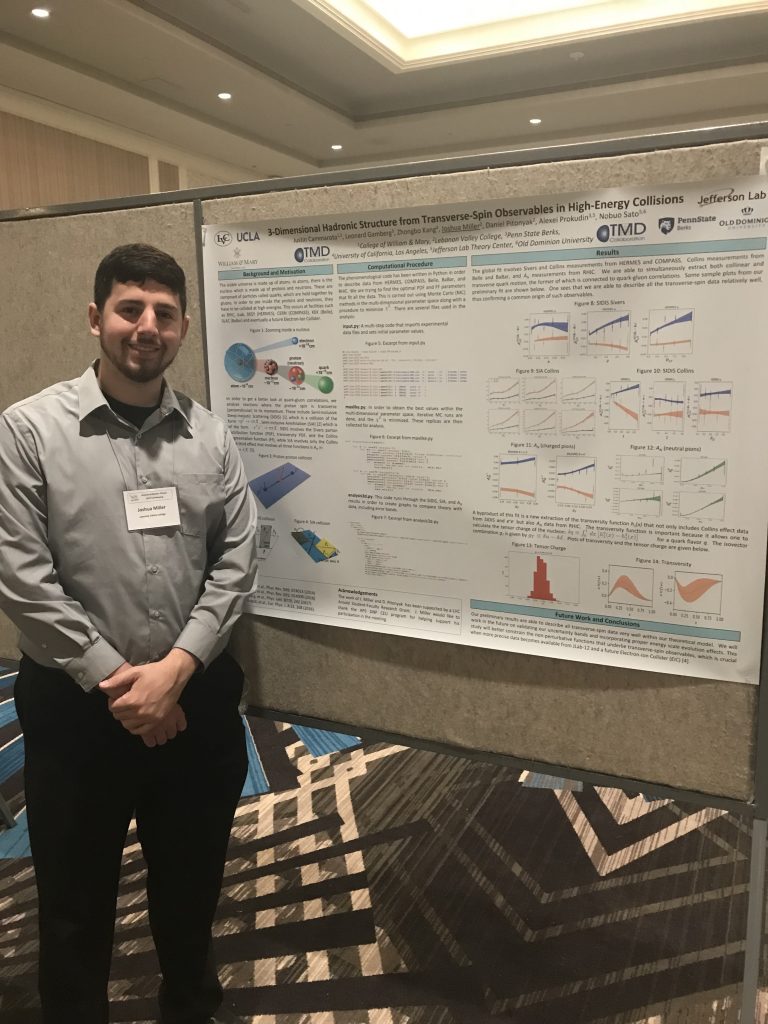Can we unlock the secrets hidden deep within the nucleus of an atom?
Everything is made of atoms, which are comprised of electrons orbiting a nucleus. Understanding the nucleus and its substructure is at the heart of nuclear physics. At Lebanon Valley College in the US, Dr Daniel Pitonyak is hoping to uncover the mysteries held deep within the nucleus of an atom.
TALK LIKE A NUCLEAR PHYSICIST
PROTON — a positively charged particle in an atom’s nucleus
NEUTRON — a neutral particle (one that has no charge) in an atom’s nucleus
HADRONS — the collective name for any particle that interacts via the strong nuclear force, e.g., protons and neutrons
ELECTRON — a negatively charged particle orbiting an atom’s nucleus
QUARKS — particles inside hadrons, e.g., protons are made of three quarks
GLUONS — particles that hold quarks together inside of hadrons
PARTONS — the collective name for quarks and gluons
QUANTUM CHROMODYNAMICS — the theory that describes how quarks and gluons interact through the strong nuclear force
SPIN — a quantum-mechanical property of particles, similar to the angular momentum of a sphere rotating on its axis, which has the effect of creating a bar magnet within the particle
Full of exotic-sounding particles, and existing on a scale billions of times smaller than the width of a human hair, the world of nuclear physics can be daunting and bewildering. Until the turn of the 20th century, it was generally believed that everything was made of atoms, and that these atoms were the fundamental units of matter. Indeed, the word atom comes from the ancient Greek word ‘atomos’, meaning ‘indivisible’.
However, thanks to the work of nuclear physicists like J.J. Thomson and Ernest Rutherford, we now know that atoms are composed of even smaller particles. Each atom is comprised of electrons orbiting a very small, dense nucleus made up of protons and neutrons. And these protons and neutrons can then be split into smaller components still, called quarks. Quarks are a type of ‘elementary particle’ that cannot be further subdivided.
This is where nuclear physics starts to get more complex. Quarks come in six different types, or ‘flavours’, – up, down, top, bottom, strange and charm – and they are held together by gluons, another type of elementary particle. Collectively, quarks and gluons are known as partons. The larger particles composed of quarks and gluons (e.g., protons and neutrons) are collectively known as hadrons.
Confused yet? If you are struggling to follow this, do not panic! Even seasoned physicists, like Dr Daniel Pitonyak from Lebanon Valley College, are still working hard to unravel the mysteries of this strange subatomic realm. Daniel’s research lies within the field of high-energy nuclear physics, which investigates how parton interactions and motions influence the internal structure of hadrons.
QUANTUM CHROMODYNAMICS
Some particles, like protons and electrons, carry an electric charge which allows them to interact via electric and magnetic forces by exchanging photons. Quarks and gluons carry another type of charge, known as a colour charge, which allows them to interact via the strong nuclear force. It is these interactions that the theory of quantum chromodynamics sets out to describe. Since hadrons are composed of quarks and gluons, all their properties must arise from and be determined by their constituent partons. For example, we should be able to explain the proton’s spin in terms of the quarks and gluons within it.
WHAT IS SPIN?
Spin is a fundamental property of a particle, like its mass or charge, and is a measure of its intrinsic angular momentum. “The particle is not literally rotating,” explains Daniel. “The spin of a particle has the effect of creating a tiny bar magnet inside it that can respond to a magnetic field.”
The value of a particle’s spin must follow certain rules. It must be either a whole number (1, 2, 3, etc.) or half a whole number (1/2, 3/2, 5/2, etc.) multiple of ℏ (pronounced ‘h-bar’), a fundamental constant that shows up in quantum mechanics. Protons, neutrons, electrons and quarks all have a spin of ℏ/2, while photons and gluons have a spin of ℏ.
WHAT CAUSES A PROTON’S SPIN?
“Typically, spin is measured by observing the direction that a particle is deflected when passing through a magnetic field,” says Daniel. One of the main aims of his research is to determine the source of the proton’s spin. “Since a proton is composed of quarks and gluons, its spin of ℏ/2 must arise from its partons,” he explains.
There are two ways in which the partons (quarks and gluons) contribute to the proton’s spin. Firstly, the partons themselves carry spin and this is transferred to the proton. Secondly, the partons are moving around inside the proton. This creates angular momentum which also contributes to the proton’s spin. The sum of the partons’ spins and the angular momenta created by their movement must add up to ℏ/2. “However, exactly how much comes from each component remains an open question,” says Daniel.
By analysing the results of nuclear physics experiments, it has been determined that 30% of the proton’s spin comes from the quarks’ spins and 40% comes from the gluons’ spins. However, more precise measurements are needed to increase the accuracy of these values. Daniel works on calculating how much spin comes from quarks and gluons that carry only a small fraction of the proton’s momentum, which is difficult to access through current experiments.
WHAT EXPERIMENTS ALLOW DANIEL TO STUDY SUCH TINY PARTICLES?
“Partons exist at length scales that are extremely small,” says Daniel. “We cannot simply place a proton under an ordinary microscope and see the partons moving around inside.” Instead, experimental physicists must smash protons together at incredibly high speeds. These high-energy collisions are conducted in huge particle accelerators, several miles in circumference, that can accelerate protons close to the speed of light. When the protons collide, their partons are ejected, allowing physicists to detect the hadrons they form.
Data from these experiments allow Daniel to better understand the internal structure of hadrons through functions that encode what is going on before and after the collisions. He writes code based on calculations in quantum chromodynamics of how quarks and gluons interact when protons collide, to numerically model the results of these high-energy collisions. He uses algorithms and computational techniques to determine what parameters produce models that best fit the experimental data. From these models, Daniel can discover how the partons are distributed and move within the protons and create images of their 3-dimensional (3D) structure.
WHAT IS THE ELECTRON-ION COLLIDER?
The Electron-Ion Collider (EIC) is a particle accelerator, recently commissioned by the US Department of Energy, which will offer unprecedented insight into the internal structure of hadrons. Thousands of physicists from around the world have been collaborating to design and create the EIC, including Daniel. “I have been involved in analysing how the specifications of the EIC will quantitatively impact our current understanding of the 3D structure of hadrons and how much of the proton’s spin arises from quarks and gluons, to ensure the collider is built in a way that maximises its scientific outcomes,” he explains.
The construction of the EIC will offer nuclear physicists the chance to advance their research. In the meantime, Daniel’s next steps involve creating more complex models that can account for phenomena such as gluon radiation. This will allow him to include additional experimental data in his analyses and make more precise predictions.
WHY IS THIS RESEARCH IMPORTANT?
“This research attempts to understand the most elementary structure of visible matter in our Universe,” says Daniel. “It’s what we are made of at a fundamental level. Moreover, this research involves young scientists who receive the training necessary to branch out into other STEM fields or areas of physics research. Developing and sustaining a scientific workforce is crucial for creating new technologies and solving the critical problems that face our world.”
 DR DANIEL PITONYAK
DR DANIEL PITONYAK
Assistant Professor of Physics, Lebanon Valley College, USA
FIELD OF RESEARCH: Nuclear Physics
RESEARCH PROJECT: Investigating the 3D structure of hadrons and the origin of the proton’s spin
FUNDER: National Science Foundation (NSF) This work is supported by the National Science Foundation, under award number PHY-2011763. The contents are solely the responsibility of the authors and do not necessarily represent the official views of the National Science Foundation.
Reference
https://doi.org/10.33424/FUTURUM293
ABOUT NUCLEAR PHYSICS
Nuclear physics is the field of science that studies the atomic nucleus, its components and their interactions. Despite its complexity, nuclear physics has many real-world applications. Some of these applications are stumbled upon during something known as ‘blue skies’ research. Blue skies research is conducted without real-world applications in mind and is instead led by curiosity and the quest for deeper insight into the nature of reality. Often, fundamental research such as this leads to scientific breakthroughs that no one anticipated.
There are still many open questions that nuclear physics has yet to answer. “With the Electron-Ion Collider set to be completed in the early 2030s, there are decades of work ahead of us,” says Daniel. “The young people of today who become involved in this field will eventually be at the forefront of it.”
WHAT TOPICS DO NUCLEAR PHYSICISTS INVESTIGATE?
“Nuclear physics is a broad area of research,” says Daniel. “It investigates the structure of atomic nuclei and their interactions, as well applications to technology.” The research of nuclear physicists can range from studying the substructure of nuclei to investigating the creation of matter in the early Universe and the inner workings of stars. Some nuclear physicists study applications in medical imaging and cancer treatments, while others focus on alternative energy and other uses of radioactive decay.
WHAT ARE THE REWARDS AND CHALLENGES OF NUCLEAR PHYSICS RESEARCH?
“I enjoy working on unsolved problems,” says Daniel. Through his work, he is adding to our knowledge of the internal structure of matter at the most fundamental level. Daniel also enjoys the process of discovering new knowledge, despite its difficulties. “Each project has its own challenges, obstacles and complexities,” he says. “Overcoming these to find a solution that helps our field to progress is very rewarding.”
As is so often the case with research, there is not always a clear and direct path towards the end of a project. Unexpected issues can arise, and results may contradict previous data and theories. Solving these problems may need technical solutions, such as creating new code, or looking at the results from different perspectives.
THE IMPORTANCE OF COMPUTATIONAL AND PROGRAMMING SKILLS
Physicists need to be able to take intricate formulas and complex data sets, then write computer code for them in a logical and efficient manner. Programming is vital in many areas of science. Developing an understanding of how coding languages work and practicing on smaller problems is a great way to develop this skill.
EXPLORE CAREERS IN NUCLEAR PHYSICS
• The applications for nuclear physics are vast and varied. Because of this, you could find yourself working in fields as diverse as energy, medicine, agriculture or even archaeology.
• The US Department of Energy’s Nuclear Physics website (www.energy.gov/science/np/nuclear-physics) is a great place to explore the applications of nuclear physics.
• The European Nuclear Society (www.euronuclear.org) gives a broad overview of the areas covered in nuclear physics and discusses possible career options.
• Taking physics classes in high school is the first step to exploring your interest in the subject.
• “Any area of physics requires strong mathematical, computational and experimental skills,” says Daniel. Develop these by taking classes such as mathematics, calculus and programming.
• Most universities offer degrees in physics, which will provide the most direct route to a career in nuclear physics. A physics degree will involve courses in advanced theoretical, computational and experimental physics topics and advanced mathematics.
HOW DID DANIEL BECOME A NUCLEAR PHYSICIST?
WHAT WERE YOUR INTERESTS WHEN YOU WERE YOUNGER?
From an early age, I was always interested in math and science, and enjoyed and excelled in both subjects. When I took my first physics class in high school, I knew this was what I wanted to pursue. It is the ultimate combination of math and science.
WHO OR WHAT INSPIRED YOU TO BECOME A NUCLEAR PHYSICIST?
In my first year of college, I read a book called The Elegant Universe by Dr Brian Greene and became fascinated with understanding the structure of matter at the level of elementary particles.
One of my undergraduate professors, Dr Scott Walck, helped me work through a textbook on elementary particle physics, even though it was not a course taught at my college. My PhD advisor, Dr Andreas Metz, exposed me to some of the outstanding problems in understanding the substructure of hadrons and helped me to develop the skills I needed to continue in this area of research. All of these played a role in inspiring me to pursue a career as a nuclear physicist.
WHAT ARE YOUR PROUDEST CAREER ACHIEVEMENTS SO FAR?
The first achievement I am proud of is winning the 2015 Dissertation Award from the American Physical Society Group on Hadronic Physics, for research I performed during my PhD. The second is receiving a National Science Foundation grant for my research on the 3D structure of hadrons.
WHAT ARE YOUR AMBITIONS FOR THE FUTURE?
I hope to continue receiving funding for my work, publishing impactful papers, and motivating students to enter careers in STEM fields.
WHAT IS YOUR FAVOURITE FACT ABOUT ATOMS?
The nucleus of an atom is very dense, meaning it has a tremendous amount of mass packed into an extremely small volume. If you had a tablespoon of nuclear matter, it would weigh over 1 billion tons!
DANIEL’S TOP TIPS
01 Get involved in science-based after-school activities or summer camps.
02 Take as many advanced mathematics classes as you can and study computer programming.
03 At college, get involved in research with faculty members as soon as you can, even if it isn’t the exact field that you want to get into. The experience will be invaluable.
Do you have a question for Daniel?
Write it in the comments box below and Daniel will get back to you. (Remember, researchers are very busy people, so you may have to wait a few days.)













Dear Daniel,
I hope you are well.
Very interesting stuff you are working on. Recently I’ve developed an interest in quantum physics. So just a quick question…
“why are protons and electrons charged while neutrons are not?”
Dear Sajid,
Thanks for your question. We really don’t know (yet) why certain fundamental constants (charge, mass, etc.) have certain values. They seemingly need to be this way for us to be here and our universe to exist in its current state, but we have no theory (yet) that predicts their values. This is one goal of a so-called “Theory of Everything”. One could perhaps argue that protons are positively charged and electrons are negatively charged so that they can attract each other to form atoms. Neutrons have no electric charge so that they can help hold the nucleus together via the strong force without creating a repulsive electric force that could break atoms apart.